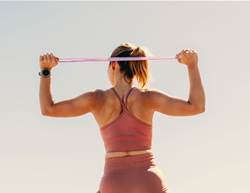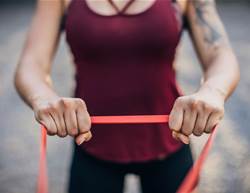If you want to build muscle and improve power and endurance, resistance bands are one of the best strength training tools you can use. Unlike dumbbells and kettlebells, resistance bands put less pressure on the joints and can target small and large muscle groups at once. Ranging from light to heavy, there are different levels of resistance you can work with.
"Resistance bands are great because you can bring them with you anywhere, and there are a varying degrees to make it more challenging, or scale it back," says Betina Gozo, Nike master trainer.
Resistance bands are particularly useful for working your lower body, including the legs and glutes, because they force you to move with better form and produce power from the right muscles, Gozo says. If you suffer from knee pain, resistance bands are especially handy for strengthening the muscles around the joint so they can stand up to a heavier load.
"The external feedback of the resistance can help you adjust your stance or think about activating certain muscles to get the most out of the exercise," Gozo says. "For example, if you're someone that tends to let their knees cave in when you squat, placing a resistance band above your knees is a good reminder to drive your knees out," she says.
Not sure how to get started? Gozo designed this resistance band leg workout below.
Reps: 15 to 20 reps for two to three rounds
Equipment: One medium to heavy resistance band and a yoga mat.
1. Fire hydrant
The gluteus maximus—the largest muscle in your glutes—get the most love when it comes to butt exercises, but doing more exercises that involve abduction—moving your legs away from the midline—can help you target the smaller muscles. This fire hydrant exercise activates the gluteus medius and minimus by moving against the resistance of the band.
How to do fire hydrants: Place a resistance band just above your knee and get into tabletop position with your hips directly over your knees and your shoulders over your wrists. Engaging your glutes and outer thighs, lift your left knee out to the side without shifting your hips. Be sure to tighten your core so your upper body stays stable. Bring your left knee back to the starting position. Continue for 10 reps before switching sides.
2. Tabletop glute kickbacks
This variation of kickbacks fires up your glutes while tightening your core. The challenge here will be to keep your upper body and hips square and stable. A good visualization is to imagine pushing the wall behind you with your heel. You can really feel your glutes working. While this exercise primarily works your lower body, it's important to press your hands down on the ground to keep your shoulders in place.
How to do tabletop glute kickbacks: Place a resistance band around the arches of your feet and get into tabletop position with your hips directly over your knees and shoulders over your wrists. Squeezing your glutes and core, kick your left foot directly behind you, forming a straight line from your heel to the top of your head. Continue for 10 reps before switching sides.
3. Glute bridge pulses
Glute bridges are an excellent way to strengthen the pelvic floor and open up the hips. When you place a resistance band just above your knees, as shown here, you're also engaging your outer thigh muscles to drive your knees out. Just be careful not to lift your hips too high to prevent overarching the low back.
How to do glute bridge pulses: Place a resistance band your thighs, just above your knees. Lie face up on a yoga mat with your knees bent, feet flat on the floor, and arms by your sides. Tightening your glutes and pelvic muscles, press your hips up toward the ceiling and pulse your hips up and down, never letting your butt touch the ground. Continue for 15 to 20 reps. For a a more challenging variation, make it a single-leg glute bridge by lifting one leg off the ground.
4. Glute bridge with alternating leg raise
Your lower abs and stability get tested with this glute bridge exercise. Lifting one leg at a time with a resistance band around your thighs offsets your balance and makes your glutes work harder to keep them lifted off the ground.
How to do a glute bridge with alternating leg raises: Place a resistance band around your thighs, just above your knees. Lie face up on a yoga mat with your knees bent and feet flat on the floor. Tightening your glutes and pelvic muscles, press your hips up toward the ceiling. While keeping your hips lifted and driving your knees out against the resistance of the band, kick your left foot out in front of you and place it back down to the ground. Press your right foot firmly on the ground to help keep your body stable. Then kick your right foot out and place it back down to the ground, pressing your left foot firmly on the ground. Continue alternating sides for 15 to 20 reps.
5. Clamshell
Working your inner and outer thigh muscles, the clamshell exercise forces you to move with control and focus on proper form. Widen your thighs so the band stretches as high as you can before lowering your knee back down.
How to do clamshells: Place a resistance band around your thighs, just above your knees. Lie on your right side on a yoga mat and bend your knees. Rest your head on your right hand or on your right forearm, and place your left hand on your left hip. Working against the band, squeeze your glutes and thigh muscles to press your left thigh out as wide as you can. Pause for a moment at the top and then slowly bring your left thigh back to the starting position. This is one rep. Continue for 10 reps before alternating sides.
6. Resistance band squats
Now that you've mastered a bodyweight squat, you can bring up the intensity of this exercise by incorporating a resistance band. As Gozo previously said, think about driving your knees out to avoid them caving in. Remember to engage your core to keep your chest lifted as well.
How to do squats: Place a resistance band around your thighs, just above your knees. Stand with your feet hip-distance apart and extend your arms out in front of you. Tightening your glutes and core, sit into a squat, pushing your butt back and down. Work against the resistance of the band to drive your knees out. Keeping your weight in your heels, firmly press them down on the ground to stand back up. This is one rep.
7. Resistance band leg lifts
As we mentioned earlier, hip abduction is a great way to target the smaller muscles in your glutes. With these resistance band leg lifts, you're also actively squeezing your thighs to out to the sides. Want to make sure you're using the right muscles? Put your hands on your hips to feel the muscles working, Gozo says.
How to do resistance band leg lifts: Place a resistance band around your ankles and stand with your feet hip-distance apart. Tightening your glutes and thighs and balancing your weight on the right leg, lift your left leg out to the side, tightening the band as much as you can without shifting your hips. Moving with control, bring your left foot back to the starting position without letting your foot hit the ground. Continue for 10 reps before switching sides.
8. Glute kickbacks
If you're sick of doing squats, these standing glute kickbacks are a great way to fire up your posterior. Even before you kick your foot behind you, be sure to tighten your glutes and press the opposite foot firmly on the ground to help you balance.
How to do glute kickbacks: Place a resistance band around your ankles and stand with your feet hip-distance apart. Tightening your glutes and tucking your pelvis in, kick your left leg out behind you until the band is tight. Pause at the top before bringing your left foot back to the starting position. Continue for 10 reps before switching sides.
9. Lateral band walk
While it might look simple, your inner and outer thighs will feel the burn with this resistance band exercise. Here, you want to step your feet out and in wide enough so that the band stays taut throughout the entire time.
How to do a lateral band walk: Place a resistance band around your ankles and stand with your feet hip-distance apart with a slight bend in the knees. Engaging your outer thighs and slightly hinging at the hips, step your left foot to the side so your feet are now shoulder-distance apart. Then step your right foot to the left, bringing your feet hip-distance apart and keeping the band tight. Alternate stepping your feet out and in for about 10 reps on each side.
10. Diagonal band walk
Improve your hip mobility by mixing up the directions in your band walks. Just like the exercise above, the key here is to keep the band taut the entire time.
How to do a diagonal band walk: Place a resistance band around your ankles and stand with your feet hip-distance apart with a slight bend in the knees. With a slight hinge at the hips, take a wide step up to the right side with your right foot while keeping the band tight around your ankles, then take a wide step up to the left side with your left foot. Continue for a few reps before reversing your steps to walk yourself back to where you started.








